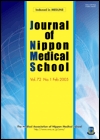80 巻, 1 号
選択された号の論文の13件中1~13を表示しています
- |<
- <
- 1
- >
- >|
Photogravure
-
2013 年 80 巻 1 号 p. 2-3
発行日: 2013年
公開日: 2013/03/08
PDF形式でダウンロード (318K)
Review
-
2013 年 80 巻 1 号 p. 4-15
発行日: 2013年
公開日: 2013/03/08
PDF形式でダウンロード (1216K) -
2013 年 80 巻 1 号 p. 16-24
発行日: 2013年
公開日: 2013/03/08
PDF形式でダウンロード (265K)
Originals
-
2013 年 80 巻 1 号 p. 25-33
発行日: 2013年
公開日: 2013/03/08
PDF形式でダウンロード (343K) -
2013 年 80 巻 1 号 p. 34-41
発行日: 2013年
公開日: 2013/03/08
PDF形式でダウンロード (295K) -
2013 年 80 巻 1 号 p. 42-49
発行日: 2013年
公開日: 2013/03/08
PDF形式でダウンロード (191K) -
2013 年 80 巻 1 号 p. 50-56
発行日: 2013年
公開日: 2013/03/08
PDF形式でダウンロード (344K)
Report on Experiments and Clinical Cases
-
2013 年 80 巻 1 号 p. 57-62
発行日: 2013年
公開日: 2013/03/08
PDF形式でダウンロード (1470K) -
2013 年 80 巻 1 号 p. 63-69
発行日: 2013年
公開日: 2013/03/08
PDF形式でダウンロード (147K)
Case Reports
-
2013 年 80 巻 1 号 p. 70-73
発行日: 2013年
公開日: 2013/03/08
PDF形式でダウンロード (464K) -
2013 年 80 巻 1 号 p. 74-77
発行日: 2013年
公開日: 2013/03/08
PDF形式でダウンロード (665K) -
2013 年 80 巻 1 号 p. 78-82
発行日: 2013年
公開日: 2013/03/08
PDF形式でダウンロード (541K)
Letter to the Editor
-
Congenital dermoid cyst at the anterior fontanelle: neuroimaging before and after fontanelle closure原稿種別: Letter to the Editor
2013 年 80 巻 1 号 p. 83-84
発行日: 2013年
公開日: 2013/03/08
PDF形式でダウンロード (70K)
- |<
- <
- 1
- >
- >|
